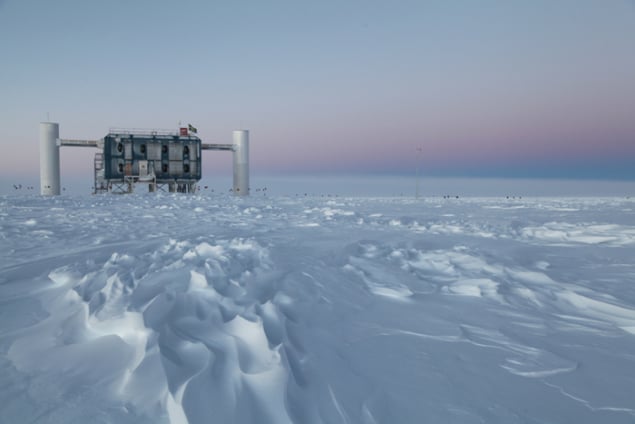
A study of Earth-transiting neutrinos detected by the IceCube Neutrino Observatory at the South Pole has determined the interaction cross-section for record-high neutrino energies. The measured value is 1.3 times that predicted by the Standard Model, but known sources of error in the analysis make the result consistent with theory.
Because neutrinos interact with matter only through gravity and the weak force, they are notoriously difficult to capture in laboratory-scale detectors. Experiments like the IceCube observatory can manage it only because of the huge target volumes that they encompass: at IceCube, more than 5000 optical sensors are spread throughout 86 vertical boreholes to monitor a cubic kilometre of ice. When neutrinos interact with nucleons within that volume, they produce muons travelling faster than the local speed of light. The faint flashes of Cherenkov radiation that result can be observed by multiple individual light sensors, revealing the direction from which the neutrino entered the experiment.
New energy range
Previous investigations of neutrino interaction have defined the particle’s behaviour up to only 370 GeV, which is the maximum accessible using accelerator-derived neutrino beams. Now, writing in Nature, the IceCube collaboration has reported the detection of naturally occurring, Earth-transiting neutrinos with energies between 6.3 and 980 TeV.
“Although only a first look, and not a precision measurement yet, for neutrinos, it is like commissioning an accelerator with more than 100 times higher beam energy,” explains Francis Halzen, principal investigator for the IceCube project. “That is a bigger step than from the Tevatron to the LHC.”
“That is a bigger step than from the Tevatron to the LHC,”
Francis Halzen, University of Wisconsin – Madison
Within the energy range investigated until now, the interaction cross-section increases linearly with particle energy. Even so, neutrinos at the top end are still exceedingly penetrating, and pass through the Earth with very little chance of being intercepted.
The significance of the higher range observed by IceCube lies in the fact that, above 10 TeV, the Standard Model predicts that the neutrino’s interaction cross-section starts to increase more slowly. Therefore, measurements in this region have the potential to pick holes in the theory through which new physics might be glimpsed.
Coming up from below
To test the theory, the researchers sifted through more than 100 million detection events and identified 10,784 muons that passed through the experiment at more than 90° from the zenith. Since these particles appeared to originate below the horizon, they represent a subset distinct from the vast majority that were created by cosmic ray collisions with the atmosphere. Muons in this subset can only have been produced by neutrinos that passed through the Earth before interacting with the detector.
The IceCube team then compared the measured flux of upward neutrinos with a reference set that arrived from shallower angles, having traversed less of the Earth’s bulk. Higher energy neutrinos, and those with angles of incidence farthest from horizontal, were attenuated to a greater degree. Using a model of the Earth’s density derived from seismic studies (and a well-constrained value for the planet’s overall mass), the researchers arrived at an energy–cross-section relationship that is consistent with the Standard Model’s predictions.
Early days
The results used in the reported analysis were gathered from observations made over just one year, in 2009 and 2010. “We have eight years’ worth of data by now and will come up with a much better measurement in the future,” says Halzen. “The number of events at high energy that are sensitive to absorption should accumulate linearly with time, so I anticipate a significant reduction of the error bars.”
These additional data will also be bolstered by observations from another site – the Cubic Kilometre Neutrino Telescope (KM3NeT), which is currently under construction. KM3NeT researcher Maarten de Jong, who was not involved in the recent work, said: “The report by the IceCube collaboration nicely shows what we can learn about these enigmatic particles by making use of cosmic particle accelerators. The KM3NeT detector will be located in the deep waters of the Mediterranean Sea instead of in ice. Once completed, it will significantly augment the sample of neutrinos recorded by IceCube, yielding a better resolution and a complementary field of view. With KM3NeT, we may be able to find out where these cosmic particle accelerators are and how they work.”



